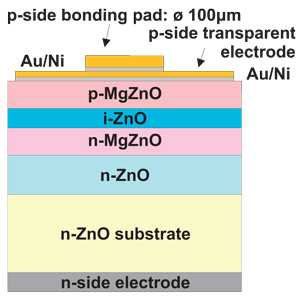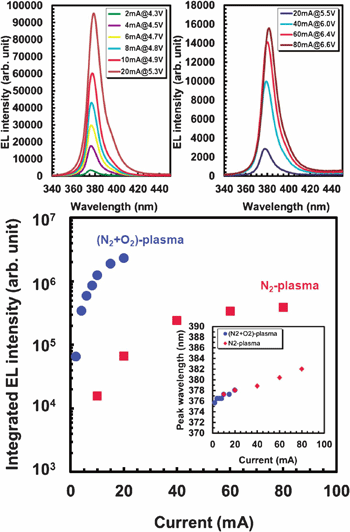- News
5 September 2011
Nitrogen/oxygen plasma improves p-type MgZnO for LEDs
Stanley Electric Co Ltd. in Japan has reported double-heterostructure light-emitting diodes (DH-LEDs) using zinc oxide (ZnO) and magnesium zinc oxide (MgZnO) layers [Hiroyuki Kato et al, Appl. Phys. Express, vol4, p091105, 2011]. The researchers also developed an improved technique for nitrogen doping, involving a nitrogen/oxygen plasma, to increase hole carrier densities in the p-type layers.
At 20mA, the intensity of the nitrogen/oxygen LED was 35x that of a nitrogen-only device. The researchers estimated the output power at 20mA for the nitrogen/oxygen LED at 30μW, by comparing with a gallium nitride (GaN) semiconductor device. Clearly, much work is still needed, since GaN devices tend to be rated in milli-Watts, not micro-Watts.
Although ZnO is an attractive material in terms of cost, as a semiconductor material the major drawback is the lack of an effective technique for creating positively charged (p-type) ‘hole’ carriers. Bulk ZnO tends to be n-type with negatively charged ‘electron’ carriers due to the presence of aluminum and silicon impurities. The substrates used by the Stanley Electric researchers had an electron charge carrier density of about 1017/cm3 and a resistivity of 0.1Ω-cm.
ZnO has a wide bandgap energy of 3.37eV that suggests ultraviolet emissions around 370nm. The exciton (electron–hole states) binding energy of about 60meV has allowed the development of optically pumped exciton lasers. Recently, single-heterostructure LEDs have been developed by Stanley using layers of MgZnO.
 Figure 1: Schematic of ZnO-based DH-LED.
Figure 1: Schematic of ZnO-based DH-LED.
The researchers have now produced double-heterostructure p-MgZnO/ZnO/MgZnO LEDs (Figure 1) with the p-type conduction achieved through doping with nitrogen. The p-layers were deposited using plasma-enhanced molecular beam epitaxy (PAMBE). Since ZnO and MgZnO tend to be n-type conducting, there is no need for special doping to achieve n-layers. The hydrothermally grown (0001) ZnO substrates were supplied by Tokyo Denpa. The undoped ZnO/MgZnO layers were grown at 900°C. The MgZnO layers consisted of 30% Mg and 70% Zn.
The p-MgZnO was grown at the lower temperature of 700°C. The doping was carried out according to two different recipes. In the more traditional method, pure nitrogen gas was used with a flow of 1.0 standard cubic centimeters per minute (sccm). The new method consisted of a mixture of nitrogen (1.0sccm) and oxygen (0.2sccm). Both methods incorporated 2x1020/cm3 nitrogen atoms in the MgZnO structure.
 The p-electrode consisted of a 300μm x 300μm transparent square region of thin layers of nickel-gold and a thicker circular nickel-gold pad 100μm in diameter.
The p-electrode consisted of a 300μm x 300μm transparent square region of thin layers of nickel-gold and a thicker circular nickel-gold pad 100μm in diameter.
The turn-on voltage of the devices was 4–5V. The sharp emission peak occurred around 380nm (Figure 2). The new p-doping method with nitrogen/oxygen source had much improved emission and lower leakage current under reverse bias.
The peak shifted to longer wavelengths under higher drive currents (Figure 2). Between 2mA and 20mA, the nitrogen/oxygen plasma LED red-shifted from 276nm to 378nm. The nitrogen plasma LED moved its peak wavelength from 377nm to 382nm between 10mA and 80mA.
Figure 2: Effect of operating current on: near-band-edge EL spectra of LEDs fabricated using (N2/O2)-plasma (a) and pure N2-plasma (b); integrated EL intensity in range 360–420nm (c); and, peak wavelength of EL spectra (inset).
On the basis of first-principles theory and characterization of the nitrogen/oxygen plasma doping, the researchers believe that the effect of adding oxygen gas to the doping plasma is to reduce the number of oxygen sites that are replaced by nitrogen molecules (N2) and nitrogen-acceptor-N2 complexes. The presence of oxygen in the plasma is thought to assist in the plasma activation. The characterization included secondary-ion mass spectroscopy and optical emission spectroscopy.
Stanley Electric LEDs PAMBE ZnO substrates
The author Mike Cooke is a freelance technology journalist who has worked in the semiconductor and advanced technology sectors since 1997.
